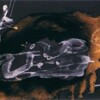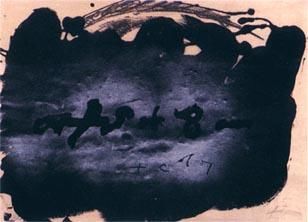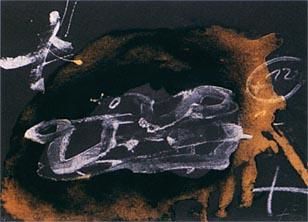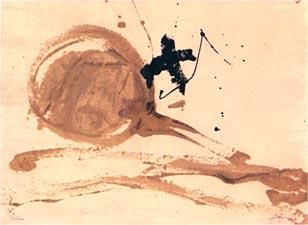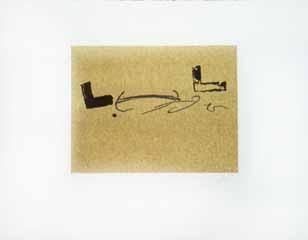Antoni Tàpies was a renowned Spanish painter and sculptor, celebrated for his innovative approach to art. Known for his non-figurative and often textured pieces, Tàpies created pieces that communicated profound philosophical and existential themes. His unique method of expression combined traditional components with unconventional elements, establishing him as a pivotal figure in contemporary art.
Biography
Antoni Tàpies Puig was born on December 13, 1923, in Barcelona to Josep Tàpies i Mestre and Maria Puig i Guerra. His father, a lawyer and Catalan nationalist, had a brief stint with the Republican government, which exposed Tàpies to the rich cultural and social fabric of Catalan public life and republicanism from a young age. His maternal grandmother also played a significant role in his upbringing, being deeply involved in civil and political activities.
Tàpies first encountered modern art during his secondary school years starting in 1934. He was particularly inspired by the famous Christmas issue of the magazine D’ací i d’allà, which featured reproductions of masterpieces by notable artists like Marcel Duchamp, Georges Braque, Wassily Kandinsky, and Pablo Picasso. At the age of 17, Tàpies experienced a near-fatal heart attack due to tuberculosis. He spent two years recovering in the mountains, during which time he read extensively and nurtured his burgeoning interest in art.
He attended the German School of Barcelona and later studied law for three years. However, from 1943 onwards, Tàpies decided to focus solely on his production. By 1945, he was experimenting with various components and developing a keen interest in philosophy, particularly the ideas of Jean-Paul Sartre and Eastern thought. Tàpies emerged as one of Spain's most prominent artists in the latter half of the 20th century, with his non-figurative and avant-garde productions showcased in major museums worldwide.
In 1954, Tàpies married Teresa Barba Fabregas, and they had three children: Antoni, Miguel, and Clara. He primarily resided in Barcelona. Antoni Tàpies passed away on February 6, 2012.
Style, Movement, and Subjects
Antoni Tàpies was introduced to contemporary art during his teenage years through the magazine D’Ací i D’Allà. During the Spanish Civil War (1936–39), while still in school, he taught himself drawing and painting. In the 1950s, thanks to a French government scholarship, Tàpies lived in Paris, a city he visited frequently. The French critic and curator Michel Tapié played a crucial role in promoting Tàpies’ work in Europe and beyond.
In 1948, Tàpies co-founded the Spanish post-war movement Dau al Set, which had connections to Surrealism and Dadaism. The group, led by poet Joan Brossa, published a magazine of the same name. Initially a Surrealist painter influenced by Paul Klee and Joan Miró, Tàpies soon turned to Informalism, developing a style known as pintura matèrica, incorporating non-artistic elements into his paintings. From 1953 onwards, he began using mixed media, adding materials like marble dust and clay to his paints and employing used paper, string, and rags. Notable examples include "Grey and Green Painting" (1957, Tate Gallery, London) and "Canvas Burned to Matter" (circa 1960, Honolulu Museum of Art).
By the late 1950s, Tàpies had established his international reputation and collaborated with Spanish Informal artists such as Enrique Tábara, Antonio Saura, and Manolo Millares. In 1966, he was arrested during a clandestine meeting at the University of Barcelona. His work from the 1970s reflected symbols of Catalan identity, which were opposed to the Franco regime. In 1974, he created a series of lithographs titled "Assassins", exhibited at the Galerie Maeght in Paris, in memory of the militant anarchist Salvador Puig Antich. Influenced by Pop Art in the 1970s, Tàpies began incorporating large-scale elements, such as furniture parts, into his paintings.
Tàpies began producing graphic works in 1947 and collaborated with poets and writers such as Alberti, Bonnefoy, Du Bouchet, and others. As an author of several essays, his publications include La pràctica de l’art (1970), L’art contra l’estètica (1974), Memòria personal (1978), La realitat com a art (1982), Per un art modern i progressista (1985), Valor de l’art (1993), and L’art i els seus llocs (1999). These works reflect on the social role of art and the artist, as well as his artistic and political views.
Tàpies was associated with the Art Informel and Haute Pâte movements, both prominent in Europe after the war. Although initially a Surrealist, he turned to non-figurative art from 1953 onwards, creating some of his most renowned and original works, characterized by the use of mixed materials and innovative techniques.
Famous masterpieces
Among Antoni Tàpies' most famous masterpieces are:
"Blau" (1959): This piece is renowned for its vibrant blue hues and dynamic composition. "Blau" is one of the most representative examples of Tàpies' use of color and texture to convey profound philosophical and existential meanings.
"Great Painting" (1958): Also known as "Gran Pintura," this piece reflects Tàpies' deep exploration of existential themes. It is created with oil and sand on canvas, featuring a rough surface with puncture marks and incisions. This composition is inspired by the graffiti-covered walls that Tàpies saw growing up in Catalonia during Franco's regime.
These masterpieces highlight Tàpies' mastery of form and materials, securing his place as a significant figure in modern art. For further details, you can consult the online collections of the Guggenheim and MoMA, as well as resources like WikiArt and TheArtStory.
 SUITE DE CAMPINS T-2 (2004) Painting by Antoni Tàpies
SUITE DE CAMPINS T-2 (2004) Painting by Antoni Tàpies
Analysis of some pieces
"Suite de Campins T-2" (2004) by Antoni Tàpies
"Suite de Campins T-2" (2004) is a compelling piece by Antoni Tàpies that exemplifies his signature style of the master. The piece features a dark, almost monochromatic palette with dominant black and deep blue tones creating a mysterious and contemplative atmosphere. The central part of the composition is marked by bold, sweeping brushstrokes and splatters that form a non-figurative, cloud-like shape. Embedded within this dark mass are cryptic symbols and faint markings that invite viewers to explore their hidden meanings.
Tàpies' use of texture is evident in the varied surface quality, which adds depth and tactile interest to the piece. The rough, almost raw aesthetic aligns with Tàpies' exploration of materiality and the physical properties of his mediums. This piece captures Tàpies' ability to convey complex emotions and abstract concepts through his distinctive blend of gesture, texture, and symbolism.
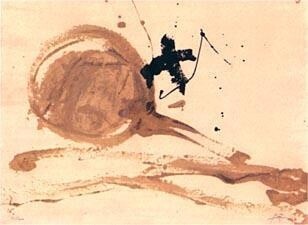 SUIT DE CAMPINS T-4 Painting by Antoni Tàpies
SUIT DE CAMPINS T-4 Painting by Antoni Tàpies
"Suite de Campins T-4" by Antoni Tàpies
"Suite de Campins T-4" is another evocative piece by Antoni Tàpies, showcasing his mastery in non-figurative expressionism. The piece features a predominantly earthy palette with shades of brown and beige creating a warm and organic background. The central element of the composition is a large, circular form rendered in a rough, textured manner, suggesting a sense of movement and fluidity.
Above this circular form, a bold, black cross-like shape is applied with dynamic brushstrokes and splatters, adding contrast and visual tension. The interplay of the earthy tones with the stark black element highlights Tàpies' skill in balancing different textures and colors. This piece, like many of Tàpies' works, integrates symbolic elements and abstract forms to evoke a range of interpretations and emotional responses.
Tàpies' use of unconventional materials and his focus on the physicality of the piece are evident in the textured surface and the raw, gestural marks. "Suite de Campins T-4" exemplifies Tàpies' ongoing exploration of the interplay between form, texture, and symbolism, making it a powerful representation of his artistic vision.
 SUIT DE CAMPINS T-3 Painting by Antoni Tàpies
SUIT DE CAMPINS T-3 Painting by Antoni Tàpies
"Suite de Campins T-3" by Antoni Tàpies
"Suite de Campins T-3" is a striking piece by Antoni Tàpies that exemplifies his non-figurative expressionist style. This masterpiece features a dramatic interplay of colors and textures, with a predominantly dark background accentuated by earthy brown and vibrant white hues. The central area of the composition is dominated by an amorphous, cloud-like form, rendered in a combination of white brushstrokes and brownish patches, creating a sense of depth and movement.
Interspersed throughout the piece are dynamic white lines and markings, adding layers of complexity and visual interest. These gestural elements introduce a sense of spontaneity and energy, characteristic of Tàpies' work. The presence of circular and cross-like symbols further enriches the piece, inviting viewers to explore its abstract narrative and symbolic meanings.
Tàpies' use of texture is evident in the rough, tactile quality of the surface, achieved through the layering of different materials. This piece reflects his ongoing exploration of the materiality of art, blending physical form with abstract expression. "Suite de Campins T-3" showcases Tàpies' ability to convey profound emotion and conceptual depth through his unique approach to non-figurative art and mixed media.
Exhibitions and Art Market Presence
Antoni Tàpies' production has been featured in numerous prestigious exhibitions worldwide, including retrospectives at the Museum of Modern Art in New York and the Museo Nacional Centro de Arte Reina Sofía in Madrid. His contributions to art were recognized with the Premio Velázquez for the Arts in 2003. In the art market, Tàpies' pieces command high prices, reflecting their desirability among collectors. His works are included in the collections of major institutions like the Tate Modern and the Centre Pompidou.
Influence on Other Artists
Antoni Tàpies has inspired countless artists with his unique approach to materials and non-figurative art. His emphasis on texture and the physicality of art has influenced contemporary artists such as Anselm Kiefer and Julian Schnabel. Tàpies' ability to blend the mystical with the material has encouraged a deeper exploration of spiritual themes in modern art.
Little-Known Facts
A lesser-known fact about Antoni Tàpies is his interest in Eastern philosophy, particularly Zen Buddhism, which profoundly influenced his artistic philosophy. Additionally, Tàpies was a prolific writer, authoring several books on art theory and philosophy, which offer insight into his creative process and intellectual pursuits.
Antoni Tàpies remains a towering figure in the world of abstract art, celebrated for his innovative techniques and profound thematic explorations. From his early life in war-torn Spain to his rise as a leading artist of the 20th century, Tàpies' journey is marked by a relentless quest for new forms of expression. His productions continue to inspire and captivate, leaving an indelible mark on the art world. Through his textured canvases and philosophical inquiries, Tàpies has cemented his legacy as a visionary who bridged the gap between material and metaphysical, making significant contributions to contemporary art.

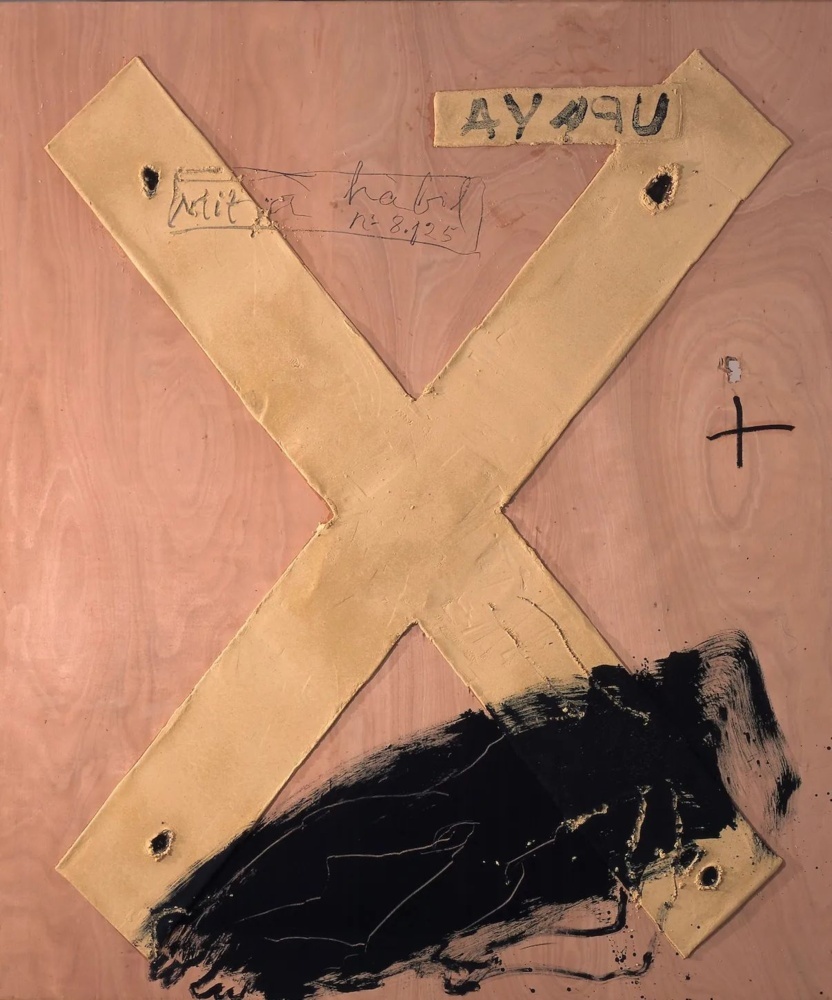
 Selena Mattei
Selena Mattei
